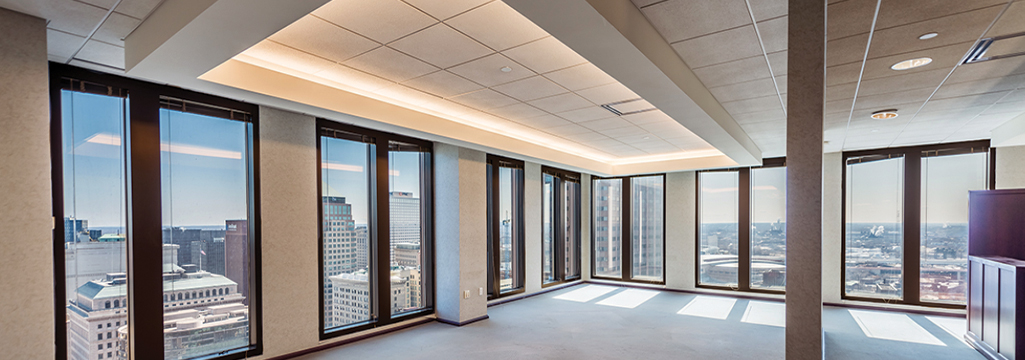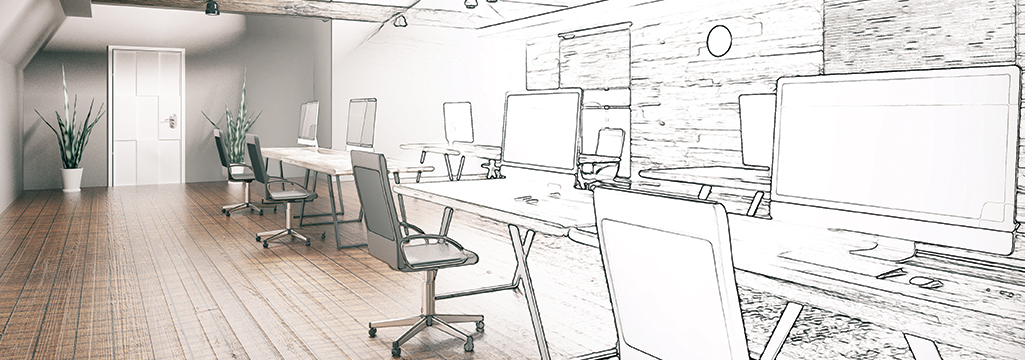

If it sparks an emotional connection—not limited to the physical environment—it can profoundly influence the employee’s professional happiness.
A University of Warwick study found that happy employees are 12 percent more productive, and are specifically more likely to work more creatively, effectively and collaboratively at work. They’re also most likely to show up at work healthy.
Driving employee experience means offering a variety of spaces for different types of work, keeping the workplace clean and safe, providing break spaces, locating your building where employees want to be, keeping the interests of your employees in mind over the interest of the company, etc.

It’s driven through engagement, empowerment and fulfillment. This is far more than just ensuring work-life balance—it also embodies company culture and values, as well as efforts to improve the internal and external perceptions towards the organization.
CHAPTER 1:
There are plenty of steps you can take today to enhance your employees’ experience every day at work.
Use evolving technology to your advantage in engaging coworkers. Technology and the influx of data are creating major disruptions, so consider how that is changing the way people work and what they need. Are your employees empowered with the right options?
Many employees are using new technologies every year at work. Because of this constant evolution, modern work arrangements are more flexible, independent contractors are frequently floating in and out of offices, and communication is heavily tech-centric. However, tech overload tends to set in after a while, and there is a desire for more human-to-human contact at work.

It’s driven through engagement, empowerment and fulfillment. This is far more than just ensuring work-life balance—it also embodies company culture and values, as well as efforts to improve the internal and external perceptions towards the organization.
While technology has its uses, human connection continually trumps the list of factors important to employee engagement at work. Nothing can top the value of experiencing nature and other humans in person.
To foster this, you can always add new and interesting spaces to your office, as long as they align with your employees’ interests and don’t make it harder for them to work. Transform the break room into a lounge, complete with couches and hammock chairs. Turn the old copy room into a project war room where employees can collaborate.
You can also experiment with coworking to spread ideas, introduce guided meditation or exercise sessions, increase events for employees to bond in and outside of work, and more.
By creating a community of humans interacting and connecting with each other, productivity, teamwork, and collaboration become easier. With these tools in hand, you can confidently deepen community and build a better workspace.
While these changes are great for a quick jumpstart on enhancing employee experience, the savvy company knows sometimes the best way to spark change is a clean slate. When employees are arriving late, leaving early, and showing minimal effort, it might be time to start from the beginning.
CHAPTER 2:
A worker’s environment plays an enormous role in productivity that cannot be discounted. This doesn’t just account for the office building, but the area around it. If your office is located in an uninteresting area with a too-small or outdated building, sometimes the best way to enhance employee experience is to announce a big move.
But where should you go? This question can, maybe surprisingly, be best answered by looking at the tech industry. Why do countless tech firms and startups cluster in certain areas? Why not spread out to conquer untapped markets?
Clustering with your competition gives you several advantages. You’ll have access to a talent pool - a natural occurrence when a industry gathers together and companies learn from each other. You’ll be able to snatch up talent leaving a competitor without having to relocate them. And you’ll attract top talent by being near other companies in your industry, creating a hub for new graduates and eager young employees.

Once you have an area in mind, it’s important to think about the building you choose. It may be tempting to choose a less expensive option, but keep in mind that a better building saves you money over time.
With a nicer building, you save money on basics like utilities. Newer buildings have better, energy saving technology to reduce these costs. Nicer buildings also offer amenities that promote employee happiness and retention, saving money on hiring costs. Finally, they generally have advanced technology, allowing for modern workplace conveniences like video conferencing, high-speed internet, and smart presentation devices.

So choose carefully! The smaller, older building may seem like a great idea up front, but you should always consider the long-term consequences of your choice.
Once you have chosen the perfect office building, it’s time to build out a space that focuses on enhancing productivity, creativity, and the overall employee experience while sticking to company strategy.
CHAPTER 3:
Are they at their desks? At home? On the road? Where do they WANT to be working?
Think of the workplace as a combination of process and experience. Oftentimes, design sacrifices one for the other, but it’s important to consider how elements like light, space, acoustics, style, and color will affect the work process and employee experience at once.

Ask your employees what types of tools, furniture, and features they want in order to succeed at work. Consider things like sustainability and environmentally friendly design. Always keep employee engagement, empowerment, and fulfillment in mind. When designing a space, ask yourself if it meets your standards for process AND experience.
Above all, keep in mind the only thing more important than an engaging workplace is an agile one. Whatever choices you make, you’ll probably have to update them in 2-5 years. A savvy company is always looking to the future.
CHAPTER 4:
As times change, company leadership needs to tip the scales more toward experience and exceed expectations to attract and retain talent.
Whether you like it or not, you’re in a constant battle with your competitors to attract younger, brighter talent to carry on the future of the company. To win it, you’ll need to provide the best experience based on what employees are looking for at that point in their career.
How do you know what employees are looking? The best and easiest way to know is to listen! Create a workspace equipped for constant feedback. Your attempts to build an engaging workspace should be fostered, trialed, and modified (or scrapped!) as needed.

And don’t forget - while you’re building the future you’ll need to make space for trends that simply can no longer be ignored. For example, the concept of wellness is so important it’s almost expected by new graduates. Many organizations launch wellness programs for the benefit of the employee, but also for reduced absenteeism and long-term health care costs.
Stay on top of these trends while constantly scanning the horizon for new ones. You need to stay nimble to thrive, be ahead of the curve, and always look out for disruptions.
If you’re creating change for them, but they’re resistant or not on board with your ideas, you’re wasting time!
When establishing a new way of working or big changes in your workspace, you can’t just dive straight in. Let’s face it – employees tend to shy away from big changes, especially all at once.
Instead, put your people first and move slowly, getting their feedback every step of the way. Building the future doesn’t happen overnight, but with small changes, you can be at the forefront of the workplace of tomorrow - one that drives employee experience while encouraging productivity and allowing creativity to thrive.
Warren Blazy, Senior Vice President
127 Public Square, Suite 1430 - Cleveland, Oh 44114
T +1 216 937 4372 | M +1 330 606 5917
Warren.Blazy@am.jll.com
jll.com
Broker License Number: SAL.2004007105